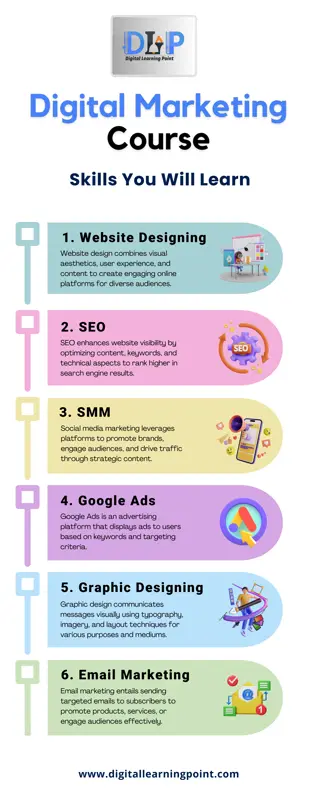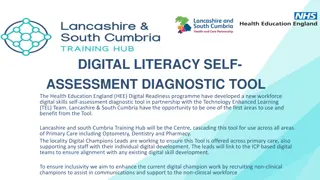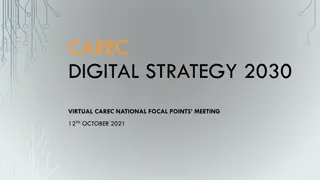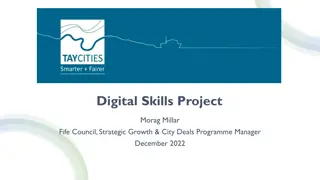Digital Skills Pack March 2021 Overview
This document provides insights into the demand for digital skills in various industries, focusing on the West of England region. It analyzes digital career pathways, skills demanded, and labor market trends. The report highlights the growth of the Digital Sector, key skills for digital jobs, and wage differentials. Key findings include the predominance of males in digital roles and the significant presence of digital jobs across multiple sectors. Overall, it offers valuable intelligence for skill provision and identifying gaps in the digital workforce.
Download Presentation

Please find below an Image/Link to download the presentation.
The content on the website is provided AS IS for your information and personal use only. It may not be sold, licensed, or shared on other websites without obtaining consent from the author. Download presentation by click this link. If you encounter any issues during the download, it is possible that the publisher has removed the file from their server.
E N D
Presentation Transcript
Digital Skills Pack March 2021 (updated July 2021)
Introduction This purpose of this document is to: (1) demanded within the digital sector and other industries with a large digital component, and analyse the skills demanded within different digital career pathways within these sectors. Provide Labour Market Intelligence highlighting skills Data The data in this report is derived from EMSI Economic Modelling, a tool that collates economic data from a variety of national datasets, as well as performs web-scraping functions. Where possible, the underlying data-source has been referenced. (2) Contribute evidence to the ongoing process of identifying where gaps in skills provision exist (currently being undertaken as a separate exercise) that, if filled, could see significant benefits for the region. The bulk of the research was carried out in early 2021 and has been updated in May 2021. Contents (3) To provide digital labour market intelligence trends from other sources which add understanding to the data and confirm more nuanced trends around digital skills within the industry and in digital roles across sectors Section Slide The Digital Sector Make- up 4 Geography Digital Jobs 9 The document refers to the West of England region. This is taken to mean the West of England Local Enterprise Partnership area, which is made up of four unitary authorities: Skills Demand in Digital Jobs 16 Bath and North East Somerset Further Labour Market Intelligence 26 Bristol Forecasts 30 North Somerset South Gloucestershire Appendix 32
Summary The report looks at the Digital Sector (businesses in the information and communications industry) and Digital Jobs (jobs primarily requiring digital skills and responsibilities) separately, as defined in their respective sections. It also looks at Digital Pathways, highlighting key skills in different occupational pathways in digital jobs. Some high-level key points from each section are included below. The Digital Sector In 2019, the West of England region had 22,200 jobs in the Digital Sector. This is 7% above the national average. Digital Pathways Five digital pathways are analysed in this report, all of which require different skillsets, although there is significant cross over between the pathways (see Digital Pathways section). The Digital Sector grew at a slower rate in the region than nationally, with 13.8% growth in the region between 2010 and 2019 (in terms of number of jobs) compared to 35.9% at a national level. Eight specific skills are cited as required in more than 10% of digital job postings. These include: In 2019, the average wage in the digital industry in the West of England was 38.7k, 17.8% lower than the industry national average salary of 46.9k. This is 46% higher than the region s average salary of 26.4k. Agile Methodology JavaScript Males made up 75.5% of the workforce in the Digital Sector. Digital jobs Digital jobs were predominantly held by males, at 83.3% of jobs in 2016. Python (Programming Language) SQL (Programming Language) Software Engineering Amazon Web Services The sector with the most individuals working in jobs classed by this methodology as Digital jobs was the Information and communication sector (13,838). Digital jobs make up 49.2% of jobs in this sector. Significant numbers of jobs were seen in other sectors. 10 other sectors had over 1000 digital jobs in the West of England in 2019. Software Development (Generic) C# (Programming Language) Sources: See corresponding later sections.
The Digital Sector Make-Up
The Formal Digital Sector This section examines the formally defined Digital Sector within the economy. Definition of this sector differs between sources, with some organisations conducting activities that are ambiguous in their definition. This report has been aligned with the EMSI Digital Pathways report, using the same 14 individual industries within the Government s 4-digit Standard Industry Classifications (SIC) to define the digital sector, all of which found within the broader 1-digit SIC Information and Communication sector (see table). Digital sector sub-category West of England jobs, 2019 Computer consultancy activities 7,455 Other telecommunications activities 3,015 Computer programming activities 4,947 Data processing, hosting and related activities Other information technology and computer service activities 2,634 High Level Analysis 2,769 Computer facilities management activities Web portals Wireless telecommunications activities 141 In 2019, the West of England region had 22,200 jobs in the digital industry. This is 7% above the national average. 395 223 The Digital Sector grew at a slower rate in the region than nationally, with 13.8% growth in the region (in terms of number of jobs) compared to 35.9% at a national level. Wired telecommunications activities 105 In 2019, the average wage in the digital industry in the West of England was 38.7k, 17.8% lower than the industry national average salary of 46.9k.This is 46% higher than the region s average salary of 26.4k Motion picture, video and television programme post-production activities 238 Other software publishing Publishing of computer games Satellite telecommunications activities Reproduction of recorded media 181 16 10 24 *Such as the EMSI Digital Pathways report
Sector Job Change by Geography Location Quotient 2010 and 2019 Since 2010, the Digital Sector* grew at a slower rate in the West of England region than nationally in terms of number of jobs, with 13.8% and 35.9% growth respectively. 2.5 Between 2010 and 2019, both Bristol and North Somerset experienced above UK average job growth in the Digital Sector (45% and 38% respectively). B&NES saw growth lower than average 14% growth. 2 The main driver behind the West of England experiencing below average job growth in the industry was the reduction in jobs in South Gloucestershire, which fell by 20% in the period. 1.5 South Gloucestershire went from having the highest number of digital jobs in 2010 to second contributor below Bristol in 2019 (40.4% of digital industry jobs in the region in 2010 to 28.3% in 2019.) 1 Industry location quotient (LQ) is a way of quantifying how concentrated an industry is in a region compared to the national picture, with a result of 1 indicating the region has the same concentration as the national. Of the four LAs, only Bristol increased its location quotient for digital industry jobs between 2010 and 2019, therefore showing increased specialism jobs in the Digital Sector. South Gloucestershire and Bristol have a higher concentration of Digital Sector jobs than the nation as a whole. 0.5 0 South Bath and North East Somerset Bristol, City of North Somerset South West Gloucestershire LQ 2010 LQ 2019 *As defined in The formal Digital sector slide
Labour Market Characteristics in the Digital Sector 2016 West of England Digital Industry employees by age In terms of labour market characteristics, the 25-44 age range made up 59.4% of the Digital Sector workforce in 2016*. The 45-54 age range made up 21.8%, and the 16-24 range 8.4%. 35.0% The majority of employees were males, with 75.5% of those employed across the industry being male. 30.0% 25.0% 2016 West of England Digital Industry employees by gender 80.0% 20.0% 70.0% 60.0% 15.0% 50.0% 40.0% 10.0% 30.0% 20.0% 5.0% 10.0% 0.0% 0.0% Males Females 16-24 25-34 35-44 45-54 55-64 65+ *The latest data available
Job Titles Within the Digital Sector Composition of Digital Industry jobs by job title, 2019 4,000 5 occupations made up 42.4% of the total jobs in the industry. There were: 15.4% 3,500 Programmers and software development professionals (15.4% of jobs in industry) 3,000 9.6% 8.7% 2,500 IT specialist managers (9.6%) 4.2% 4.5% 2,000 Information technology and telecommunications professionals n.e.c. (8.7%) 1,500 1,000 Sales accounts and business development managers (4.5%) 500 IT project and programme managers (4.2%) 0 Managerial, sales and project management skills feature highly in this list, highlighting that the industry relies on both technical and non- technical skills, and the importance of transferable and soft skills. IT specialist managers IT operations technicians telecommunications professionals n.e.c. Sales accounts and business development Programmers and software development Information technology and professionals managers *Such as the EMSI Digital Pathways report
Digital Sector and Digital Jobs Not all jobs in the digital sector are digital jobs, and not all digital jobs are in the digital sector. The sector with the most individuals working in jobs classed as digital jobs was the Information and communication sector (13,838), in which the digital sector sits, with 50.8% of digital jobs sitting outside of the digital sector. Other Sectors Digital Sector Digital Jobs
Digital Jobs Many digital jobs fall outside of the formally defined Digital Sector within the economy. Digital skills are increasingly demanded across economic sectors, with some studies* finding over 50% of digital jobs to be outside of the formal digital sector. This report defines digital jobs as the 17 3-digit SOC classifications found in the table (right), in line with the EMSI Digital Pathways Report. 3 Digit Standard Occupational Classification Information technology and telecommunications directors Electrical engineers IT specialist managers IT project and programme managers The number of digital jobs in the region has increased since 2010. IT business analysts, architects and systems designers West of England Digital Jobs Programmers and software development professionals 34000 Web design and development professionals 33000 Information technology and telecommunications professionals n.e.c. 32000 Electrical and electronics technicians IT operations technicians IT user support technicians Graphic designers Telecommunications engineers TV, video and audio engineers IT engineers Electrical and electronic trades n.e.c. Pre-press technicians 31000 30000 29000 28000 27000 26000 25000 2010 2011 2012 2013 2014 2015 2016 2017 2018 2019 *EMSI Digital Pathways Report
Digital Jobs Demographics 2016 Digital jobs by age, West of England 35.0% In 2016*, the age profile of those in Digital jobs in the West of England region was similar to those in the Digital Sector**, with the 25-34 and 35-44 age groups together making up the majority of individuals. The next highest levels were in the 45-54 age group, at 22.7% of the workforce. 30.0% 25.0% 20.0% 15.0% 10.0% In the West of England, the 25-34 and 35-44 age groups represented a greater proportion of Digital jobs than jobs in the labour market as a whole. 5.0% 0.0% 16-24 25-34 35-44 45-54 55-64 65+ Digital jobs were predominantly held by males, at 83.3% of jobs in 2016. This is higher than in the Digital sector specifically, where males still hold the majority of jobs but to less of an extent (75.5%). 2016 Digital jobs by age, West of England 90.0% 80.0% Some studies have found that females in the digital sector are more likely to undertake roles in sales, HR and project management***. This could explain the higher levels of males in digital roles across sectors, when compared to the digital sector specifically, although this is not known to be the case in the West of England specifically. 70.0% 60.0% 50.0% 40.0% 30.0% 20.0% 10.0% 0.0% *The latest data available **As defined in the Digital Sector Make-up section ***Women in Digital: A study into gender representation, link Males Females
Digital Jobs by Local Authority Number of digital jobs and % change since 2010, by LA Bristol saw the highest level of digital jobs in 2019, at 15,249. This was followed by South Gloucestershire (9,269), Bath and North East Somerset (4,515) and North Somerset (3,584). 35,000 35% Although it had the lowest levels, North Somerset saw the largest percentage increase in digital jobs since 2010, at 32.47%. Bristol saw the second largest increase at 24.39%, followed by Bath and North East Somerset (5.15%). South Gloucestershire saw a small decrease in digital jobs (-0.98%). 30% 30,000 25% 25,000 The overall growth rate for digital jobs was higher than for jobs as a whole in the region, at 14.0% and 11.3% respectively. 20% 20,000 15% The growth rate in digital jobs between 2010-2019 was 20.4 percentage points lower for the West of England region than England as a whole, which saw 34.4% growth in these jobs. 15,000 10% 10,000 5% 5,000 0% 0 -5% West of England South Bath and North East Somerset Bristol, City of North Somerset Gloucestershire 2019 Jobs % Change since 2010
Digital Jobs by Sector Occupation Group Jobs in Industry (2019) 7% 5% The sector with the most individuals working in jobs classed by this methodology as Digitaljobs was the Information and communication sector (13,838). Digital jobs make up 49.2% of jobs in this sector. 7% 5% 4% 4% Significant numbers of jobs were seen in other sectors. 10 other sectors had over 1000 digital jobs in the West of England in 2019. These were: 13% 3% Professional, scientific and technical activities (4,330) 16% Public administration and defence, compulsory social security (2,252) 3% Manufacturing (2,111) 3% Financial and insurance activities (1,627) 1% 1% 1% Construction (1,626) 43% Wholesale and retail trade repair of motor vehicles and motorcycles (1,415) Information and communication Professional, scientific and technical activities Public administration and defence; compulsory social security Manufacturing Financial and insurance activities Construction Wholesale and retail trade; repair of motor vehicles and motorcycles Education Administrative and support service activities Human health and social work activities Other service activities Transportation and storage Electricity, gas, steam and air conditioning supply Arts, entertainment and recreation Education (1,282) Administrative and support service activities (1,043) Human health and social work activities (1,036) (Sectors with under 200 digital jobs were omitted)
Digital Jobs Some sectors rely on digital jobs as a key component of their workforce. Looking at the number of digital jobs as a proportion of the total workforce of a sector indicates the prevalence of digital jobs in that industry. Sectors by proportion of digital jobs 60% Digital jobs make up 49.2% of all jobs in the Information and communication sector, almost half of all jobs. A number of other sectors also see relatively high proportions of jobs being digital 8.1% Financial and insurance activities jobs are digital, for example. 50% 40% 30% Occupation Group Jobs in Sector (2019)% of Total Jobs in Sector (2019) 20% Sector Information and communication 13,838 49.2% 10% Professional, scientific and technical activities 4,330 7.4% 0% Public administration and defence; compulsory social security management and remediation Construction Education Manufacturing Water supply; sewerage, waste Wholesale and retail trade; repair of Mining and quarrying Other service activities Human health and social work Public administration and defence; Professional, scientific and technical Real estate activities Transportation and storage Financial and insurance activities Arts, entertainment and recreation Electricity, gas, steam and air Information and communication Administrative and support service 2,252 6.3% motor vehicles and motorcycles compulsory social security conditioning supply Manufacturing Financial and insurance activities Construction 2,111 1,627 1,626 5.8% 8.1% 5.3% activities activities activities Wholesale and retail trade; repair of motor vehicles and motorcycles 1,415 1.7% Education 1,282 2.4% Administrative and support service activities 1,043 2.2% Human health and social work activities 1,036 1.2% % of Total Jobs in Industry not classified digital (2019) Other service activities Transportation and storage 841 413 8.2% 1.5% % of Total Jobs in Industry classified digital (2019)
Skills Demanded in Digital Jobs
Sills Demanded In order to establish the skills demanded from digital jobs, this section of the report looks at job postings to identify themes in skills required by employers. Digital jobs are defined as the 17 3-digit SOC classifications found in the graph (right), in line with the EMSI Digital Pathways Report, as shown in the digital jobs slide Unique Postings (Feb 2021 - May 2021) Looking at job postings data gives an indication of the skills demanded in such roles. This is an imperfect measurement jobs with high churn could distort the data, over emphasising the importance of skills required in such roles, and the opposite could be true for jobs with low churn, under representing them in the data. Key skills must also be defined in the role description in order for the Web-scraping* tool to identify the skill. 5000 4500 4000 3500 3000 2500 2000 1500 1000 The data on this slide refers to the most recent data looking at job postings from February 2021 to May 2021. Trends are consistent with previous work done in December 2020. 500 0 High Level Analysis Programmers and software development professionals saw the highest number of postings of digital jobs, with 4,613 postings in the West of England between February 2021 and May 2021. Other IT professions also saw high levels of job postings, including Information technology, Web design and development professionals, IT specialist managers and IT business analysts, architects and system designers. *Emsi (Economic Modelling)
Hard Skills Demanded We can look at skills demanded within job postings, to get an indication of the skills demand from industry. Looking at skills demanded across digital jobs (see table) demonstrates how some skills are more frequently demanded that others across the digital sector. Skill Frequency in Postings This report focuses on hard-skills required by employers between February 2021 and May 2021. A more detailed analysis is provided in the Appendix. Agile Methodology JavaScript (Programming Language) SQL (Programming Language) Software Engineering Amazon Web Services Software Development Python (Programming Language) Microsoft Azure C# (Programming Language) Cascading Style Sheets (CSS) Java (Programming Language) React.js DevOps Automation Linux .NET Framework HyperText Markup Language (HTML) Application Programming Interface (API) PHP (Scripting Language) Git (Version Control System) Front End (Software Engineering) Docker (Software) Scrum (Software Development) Systems Engineering 17% 16% 12% 12% 11% 11% 11% 10% 10% 9% 9% 9% 8% 8% 8% 7% 7% 7% 7% 6% 6% 6% 6% 6% Key Findings 9 skills are required within more than 10% of digital job postings. These include: Agile Methodology JavaScript SQL (Programming Language) Software Engineering Amazon Web Services Software Development (Generic) Python (Programming Language) Microsoft Azure C# (Programming Language)
Soft Skills Demanded We can look at skills demanded within job postings, to get an indication of the skills demand from industry. Looking at soft-skills demanded across digital jobs (see table) demonstrates how some skills are more frequently demanded that others across the digital sector. This report focuses on hard-skills required by employers between February 2021 and May 2021. A more detailed analysis is provided in the Appendix. Skill Frequency in Postings Key Findings Communications Management Innovation Infrastructure Problem Solving Customer Service Integration Leadership Planning Operations Training And Development Enthusiasm Mentorship Research Detail Oriented Self-Motivation 25% 16% 13% 13% 11% 8% 7% 7% 7% 6% 6% 6% 5% 5% 5% 5% The top 10 soft skills demanded within job adverts between February 2021 and May 2021 were: Communications Management Innovation Infrastructure Problem Solving Customer Service Integration Leadership Planning Operations
Digital Pathways In this section of the report, key word searches are used on job adverts in order to establish the key skills demanded by specific job types. This methodology is not precise using key words to identify job types could sometimes include incorrectly categorised postings, or omit relevant postings, but checks were undertaken in order to ensure searches broadly capture the correct types of postings. West of England job postings found by key-word search (Dec 2020) When searching, key words were split out using AND syntax, rather than being searched as a phrase. For example, Games AND Animation covers job postings that cite either games or animation, or both. 25000 On each of the following slides we have pulled out some of the incorrectly categorised postings which have likely skewed the data because of key word searching. 20000 The pathways analysed were inspired by the EMSI Digital Pathways Report, and sense checked to ensure they are representative of the digital space. The 5 pathways identified and analysed are Analytics 15000 10000 Cyber Security Games and Animation 5000 Networking and Cloud Infrastructure Programming and Software Development Please note this work hasn t been updated since December 2020 data, but it is expected analysis would be largely the same based on other updated analysis remaining unchanged. 0 Analytics Cyber Security Games and Animation Networking and Cloud Infrastructure Programming and Software Development Source: Emsi (Economic Modelling)
Analytics 1,492 unique postings % postings with skill Top Skills Skill Postings with Skill Data Analysis SQL (Programming Language) Agile Methodology Python (Programming Language) Auditing Key Performance Indicators (KPIs) Power BI Project Management Data Science Automation Business Intelligence Software Development Microsoft Azure Business Development Analytics Customer Relationship Management Forecasting Java (Programming Language) Amazon Web Services Data Management Google Analytics Accounting Machine Learning Stakeholder Management Dashboard Big Data R (Programming Language) Supply Chain Digital Marketing JavaScript (Programming Language) 367 286 230 217 129 119 114 111 104 103 101 98 95 95 94 93 91 86 83 83 81 80 80 75 74 72 72 71 71 69 24.6% 19.2% 15.4% 14.5% 8.6% 8.0% 7.6% 7.4% 7.0% 6.9% 6.8% 6.6% 6.4% 6.4% 6.3% 6.2% 6.1% 5.8% 5.6% 5.6% 5.4% 5.4% 5.4% 5.0% 5.0% 4.8% 4.8% 4.8% 4.8% 4.6% Data Analysis (Generic) SQL (Programming Language) Agile Methodology Python (Programming Language) Auditing Key Performance Indicators (KPIs) Power BI Project Management Data Science Automation Business Intelligence
Cyber Security 728 unique postings % of postings with skill 53.30% 16.90% 12.50% 11.13% 10.30% 9.75% 8.65% 8.65% 8.24% 7.55% 7.55% 7.42% 7.42% 7.14% 7.01% 6.87% 6.87% 6.73% 6.18% 6.04% 6.04% 6.04% 5.77% 5.49% 5.36% 5.22% 4.95% 4.95% 4.95% Top Skills Skill Postings with Skill Cyber Security Agile Methodology Systems Engineering Linux Python (Programming Language) Cyber Threat Intelligence Amazon Web Services Auditing Java (Programming Language) Firewall Project Management Microsoft Azure Risk Management Software Development Automation Big Data DevOps Business Development Cyber Engineering Information Assurance Software Engineering Vulnerability Risk Analysis Scrum (Software Development) ISO/IEC 27001 Operating Systems JavaScript (Programming Language) Data Analysis Computer Science 388 123 91 81 75 71 63 63 60 55 55 54 54 52 51 50 50 49 45 44 44 44 42 40 39 38 36 36 36 Cyber Security (Generic) Agile Methodology Systems Engineering (Generic) Linux Python (Programming Language) Cyber Threat Intelligence Amazon Web Services Auditing (Generic) Java (Programming Language) Firewall Project Management
Games and Animation 300 unique postings % of postings with skill 28.00% 16.67% 13.67% 13.33% 10.67% 9.00% 8.67% 8.33% 7.67% 7.00% 6.33% 6.33% 6.33% 6.00% 5.67% 5.67% 5.33% 5.33% 5.33% 5.33% 5.33% 4.67% 4.67% 4.67% 4.67% 4.67% 4.33% 4.33% 4.00% Top Skills Skill Postings with Skill Animations JavaScript (Programming Language) Cascading Style Sheets (CSS) Agile Methodology HyperText Markup Language (HTML) C# (Programming Language) Adobe Photoshop Application Programming Interface (API) Front End (Software Engineering) User Experience PHP (Scripting Language) Adobe Illustrator Microsoft Azure SQL (Programming Language) .NET Framework Scrum (Software Development) Git (Version Control System) Adobe After Effects Python (Programming Language) Scripting React.js HTML5 C++ (Programming Language) Node.Js WordPress Test-Driven Development (TDD) Computer Animation User Interface Copywriting 84 50 41 40 32 27 26 25 23 21 19 19 19 18 17 17 16 16 16 16 16 14 14 14 14 14 13 13 12 Animations (Generic) JavaScript (Programming Language) Cascading Style Sheets (CSS) Agile Methodology Hypertext Mark-up Language (HTML) C# (Programming Language) Adobe Photoshop Application Programming Interface (API) Front End (Software Engineering) (Generic) User Experience PHP (Script Language)
Networking and Cloud Infrastructure 3,036 unique postings % of postings with skill 10.44% 8.89% 8.63% 8.60% 8.40% 8.14% 7.64% 7.58% 7.18% 6.75% 5.40% 5.07% 5.04% 4.94% 4.91% 4.68% 4.51% 4.51% 4.48% 4.25% 4.05% 3.99% 3.92% 3.59% 3.59% 3.43% 3.26% 3.16% 3.16% Top Skills Skill Postings with Skill Agile Methodology Amazon Web Services DevOps Civil Engineering Microsoft Azure Python (Programming Language) Project Management Automation Linux Business Development Engineering Design Process SQL (Programming Language) Procurement Docker (Software) Software Development Software Engineering JavaScript (Programming Language) Risk Analysis Auditing Scripting AutoCAD Operating Systems Risk Management Java (Programming Language) Systems Engineering Kubernetes Terraform Active Directory Cyber Security 317 270 262 261 255 247 232 230 218 205 164 154 153 150 149 142 137 137 136 129 123 121 119 109 109 104 99 96 96 Agile Methodology Amazon Web Services DevOps Civil Engineering (Generic) Microsoft Azure Python (Programming Language) Project Management Automation Linux Business Development Engineering Design Process Inaccuracies likely to key word searching around Infrastructure may have caused inaccuracies in some of the results in this pathway for example: Civil engineering, Engineering design process, procurement, AutoCAD, business development, risk analysis, and auditing.
Programming and Software 20,025 unique postings Development % of postings with skill 8.91% 6.84% 5.27% 4.48% 4.00% 3.89% 3.73% 3.53% 3.50% 3.42% 3.27% 3.22% 3.18% 3.00% 3.00% 2.91% 2.82% 2.70% 2.61% 2.60% 2.57% 2.54% 2.54% 2.53% 2.52% 2.44% 2.37% 2.31% 2.26% Top Skills Skill Postings with Skill Business Development Agile Methodology Auditing JavaScript (Programming Language) Nursing Software Development Project Management Python (Programming Language) SQL (Programming Language) Key Performance Indicators (KPIs) Mental Health Software Engineering Risk Analysis Accounting Procurement New Product Development C# (Programming Language) Career Development Automation Amazon Web Services Java (Programming Language) Data Analysis Risk Management Customer Relationship Management Cascading Style Sheets (CSS) Systems Engineering Selling Techniques Scrum (Software Development) Advising 1,784 1,369 1,055 897 802 779 747 706 701 685 655 644 636 601 601 583 564 540 523 520 515 508 508 506 504 488 474 463 452 Business Development Agile Methodology Auditing (Generic) JavaScript (Programming Language) Nursing Software Development (Generic) Project Management Python (Programming Language) SQL (Programming Language) Key Performance Indicators Inaccuracies likely to key word searching may have caused inaccuracies in some of the results in this pathway for example: Nursing, mental health, selling techniques.
Further Labour Market Intelligence
Skills Summit Digital Skills Intelligence On 8th July over 30 employers, skills providers and wider digital skills stakeholders met to discuss digital skills needs. Various themes were discussed with a panel of experts with wider stakeholders feeding in. The below summarises the key themes discussed. Panel members included Ben Sharrock TechSpark There are not enough junior roles within the digital sector. Companies are either not investing enough in newly qualified staff/juniors or do not feel financially able to invest in junior staff. As a result, this means that those qualifying are not getting the opportunities they need to make that first step in to a digital role and our pipeline of talent is being lost. This is also leading to a continued lack of diversity within these roles, as where there are now inclusive programmes out there delivering digitals skills, without these junior roles for these individuals to move in, the lack of diversity in these sectors will remain. Chris Lewis Broadridge Margaret Davidson IO Academy Dr Richard Hourizi Institute of Coding Key Themes The digital sector continues to grow rapidly bringing many opportunities for the region. Some tech areas e.g. Fintech and Games Tech, have experienced phenomenal growth over the last 12- 18 months as a result of the Covid-19 pandemic. Traditional pathways in to tech e.g. full-time degree courses, are no longer working for all employers and individuals leading to a skills shortage. Softer skills such as resilience and problem-solving skills are seen as highly important for employers wanting to fill these digital skills roles and need to be embedded in training. There is a serious digital skills shortage within the region. Growth and demand are outslipping supply. There are many successful initiatives and programmes already running, but the issue is scale. Individuals wanting to train or reskill in a digital role find it hard to navigate the sector. They do not always know how to break in to the sector. There needs to be clear pathways and signposting. There also needs to be clear signposting for employers so they know what is available. Employer input and involvement is vital in the development of successful digital bootcamps that lead to improved employment outcomes. There needs to be greater alignment between skills taught and skills needed, with a greater focus on employer involvement to understand these needs. Jobs & Skills Summit July 5 - 9 2021
Digital Skills Needs Themes from SMEs The University of the West of England are a key delivery partner as part of the Workforce for the Future Programme. Linked to the above is the increased ask for mentoring and peer-learning between businesses who have been through a similar process developing the same digital skills and can help each other to transfer technical skills into application facilitating this in a virtual environment has proved challenging. They have so far engaged over 60 small and medium sized enterprises (SMEs) in understanding their digital needs and are designing and delivering training to support this need. Many businesses are asking for skills to develop digital solutions which reduce duplication of processes and support transfer of data across systems such as data sorting and data architecture. Common asks is around CRM systems. Through this work key themes are starting to emerge around digital skills which are across sectors and not specialist for any one particular area of the economy. Businesses engaging so far cover 14 out of 18 sector areas so themes set out below reflect a cross- sector view. SMEs have often purchased new systems based on cost to support data management, but when the need emerges for additional or more advanced systems, they find themselves duplicating effort or starting again. Linked to this is the need for data analysis skills with the increased collection of data and being able to analyse this to inform business strategy and planning for productivity. Data analytics is the second-most cited area for support across the project with over 80% requesting upskilling. Key Themes Associated with increased data is the need for data security knowledge and GDPR, Businesses are not always aware of the risks, although a high number of businesses when presented with a list of training options opted that a cyber hygiene check was something they would be interested in. Digital marketing skills are in great demand but the skills level vary. 75% of SMEs on the programme have requested entry level marketing support with over 90% asking for support implementing strategy and more specific and advanced aspects of Digital Marketing. Businesses are very much still responding to the immediate digital upskilling need catalysed as a result of COVID, including remote working/managing. They are looking at training as a survival tool to support their businesses to make the digital shift they need right now. Businesses have not yet got the headspace to be looking much further ahead to the future of digital skills they may need to invest in for the long term. Other more experienced marketing staff need to upskill with new digital marketing and sales techniques Many businesses want to upskill in a consultative way. Learning through implementing a real piece of software or digital project rather than learning the theory. This likely reflects the speed they need to develop skills to apply immediately to their specific business need. Businesses are willing to engage in developing their digital skills needs. The vast majority of businesses have requested support across multiple areas to complement existing skills and bridge gaps across the workforce.
Jobs Market Insight Reed Technology Reed Technology are a national recruiter specialising in the sourcing of candidates with digital skills from graduate through to C-level. Through their Bristol office, during the year 2020-2021, Reed Technology have supported 120 businesses in the West of England with 607 digital vacancies. Cloud computing is continuing to become more of an essential skillset in many job specifications with cloud experience being more sought after across Infrastructure, Software Development and Data roles, as businesses realise the benefits and scalability for their business. This in turn has led to a continued development in the data market, moving more towards Data Engineering and Data Science. Likewise Security and more particularly Blockchain are continuing to grow as a focus, most particularly in the Fintech arena. As users continue to access and consume more information via mobile devices than desktops, the demand for Mobile app developers and a mobile first approach is more important than ever. Looking forward further, Machine Learning, Artificial Intelligence and IOT technologies are becoming more and more of interest to businesses as these technologies become less niche and more mainstream and their potential usage better understood. Key Themes 2020-2021 has been extremely turbulent to the economy and recruitment across all sectors and role types including digital. When lockdown hit many companies cut their contractors immediately, as their quickest route to reduce costs and most stalled permanent hiring altogether to stop and take stock of what was happening and the potential medium to long-term impact. A challenge for many was adjusting to a fully remote interview process and the idea of hiring someone without having ever met them. Despite further remote working and flexible opportunities, Bristol continues to be the tech capital of the South West, due in part to being the biggest and most populist city in the region, but also the cultural offerings with food & drink, music and nightlife are attractive as a location to live and work to 18 40 year-olds who we see continuing to make up a larger proportion in the sector and stepping into ever increasing pay bandings at an impressive rate (graduate starting salaries of 30,000+). Pleasingly there is more of a diverse population getting into tech with both an increase in women and people from specific ethnic minority groups as professionals in the sector, but there is still significant work to be done in these areas. With the demand for talent ever increasing, development bootcamps are a great way to bring more talent into the industry from more diverse backgrounds and so it s pleasing to see these becoming more and more prevalent and successful in the market. Pleasingly the digital world recovered, embraced change and began hiring again much faster than most other sectors and we have seen demand across most digital job categories increase significantly since then, however this demand for talent is far out-stripping supply more than it ever has done in recent memory, creating a candidate and skills shortage. As such, we have seen a significant increase in salaries across all areas (but most particularly Software Development, Data, Cloud, DevOps, Security and Product) as well as a steep rise in remote/hybrid working, with most roles in these areas offering 4 days per week working from home or more and many offering 100% home working arrangements where they hadn t before. This has given an opportunity for businesses in geographically remote locations such as Somerset to be able to attract talent they couldn t before, but also meant that they are now competing with businesses across the country in London etc and even internationally, in some cases having to compete with Silicon Valley. Reed Technology believe we all (recruiters, employers and educational establishments) have a part to play in closing the digital skills gap and are focussed on getting more people in to technology careers and supporting the development of digital skills, especially across under represented groups, through initiatives such as our women in technology mentoring programme, technology role models youtube channel and partnerships with groups such as www.blackgirlsintech.org For further insight in to the local market, access to digital skills salary guides or general recruitment advice contact kevin.dainty@reed.com
Priorities for Lower/Baseline Digital Skills Needs Five Adult Education Funded providers received additional funding in early 2021 to support the following aims around Digital Skills at a lower/baseline level: There is still a need for digital kit and data to support accessibility, but there are considerations which should be given to a shared/economy of scale approach to procurement and management of this. Consideration needs to be given around what that learner does when the training finishes to ensure learners can continue to progress after the training. Stimulate demand for digital provision Changing employer behaviour in terms of recruitment processes and digital work- based communication and processes are driving changes in skills delivery. For example, new types of interview skills based on the fact most job interviews are now online. Improve digital access Improving digital confidence There is expertise needed within training providers to continue to develop their digital skills for training delivery and stay up to date with the latest developments in education tech. This funding was given in extremely difficult circumstances for training providers as they worked hard to adapt their delivery and develop digital skills for online delivery themselves. Full evaluation of the benefits of this initial funding is ongoing, however a round table was held with 4 providers in July to determine what sort of impact was working well and what work is still needed. There is still a lot of work to do to proactively engage and reach out to individuals who need digital skills due to COVID but are still not engaging. There is still a lot of work to be done to engage employers who do not understand how upskilling their workforce in digital will have financial benefits immediately and support productivity. Both of the above need collaborative approaches to create a strong joint offer for businesses and individuals in the West of England with a strong marketing campaign to engage them on the benefits and support them to navigate the free of charge support and training. Key Themes COVID saw fast and unprecedented digital skills needs changes for learners and training providers themselves. Both have adapted well but there is a lot more to be done as blended learning is here to stay. The new EDSQ has been well received and develops the right skills employers are looking for. More work needs to be done to stimulate demand, but this needs to include supporting learners to have access to devices. More work needs to be done to support learners who have taken the first steps to gain baseline/lower level digital skills to access the next level of digital skills based on their chosen progression pathway, so they are aware of how to develop more sector/ job specific digital skills. There have been successes in this challenging time including: Delivering digital skills through stealth through wider course delivery Engagement of learners with online delivery especially around ESOL delivery, in many cases learners have felt there has been increased support Collaborations which have allowed delivery of digital kit and data New types of flexible delivery for example Click to Learn Assessing individuals digital skills level through a one to one consultation with skills providers is key for ensuring individuals access the right level of digital training and have the right support. This most successful when carried out with an ICT specialist tutor and face to face.
Learnings from Digital Bootcamp Training Nationally The Digital Skills Pilot in the West Midlands was the first to be introduced in a Combined Authority area, with subsequent programmes established in five other CA s including Greater Manchester, Lancashire and Liverpool City Region. The DfE have recently funded a wealth of Bootcamp style training nationally as part of the National Skills Fund with the model now being widely adopted to deliver higher level technical skills. West Midlands Learnings: Less prescription around programme requirements and greater communication encouraged more providers to engage. It is important that harder to reach individuals continue to receive support especially around clear progression routes both education and employment Many learners face significant barriers that prevent them accessing education and training programmes holistic support is key Engaging a critical mass of employers is key to maximise benefits for employers and learners Greater Manchester Learning: Employer engagement Providing a service genuinely based on employer need and designed around progressing a specific role. Initial Assessment Assess interest and passion for technology as well as potential technical capability for this type of training from the start Wrap around support High quality wrap around support is key whilst on programme and to support transition into employment. This worked best where training providers had pre-empted challenges. Course design Targeted behavioural skills and mindsets for the specific role and workplace culture. West Midlands combined Authority Digital Skills Training Pilot, Final Evaluation https://www.wmca.org.uk/media/4812/digital-skills-training-pilot-report.pdf
Forecasts for Digital Future estimates and for both the digital sector and digital jobs must be assessed broadly, due to both their uncertain nature and the variation in the classification of what comprises of digital between studies. Government backed Bright Tech Future Technation report highlights, in line with findings in this report, the fact that the majority of digital job are not in the digital sector. It also points to a large increase in vacancies, indicating that the skills are not necessarily present in the workforce. It also points out their prominence in job adverts and that they are likely to increase in prominence further yet. The broad message across studies is that the digital sector and jobs are going to continue to grow; with digital technologies permeating into more sectors. Studies Working Futures report highlights technology and the IT sector s role as part of the main engine for employment and job growth. BSD, Tech City UK, 2017 Digital sector growth outpaces national growth by over 50% in 2010-15 and is expected to continue to outpace it. Tech investment in the UK is highest in Europe, pointing to further growth. Government backed UK Tech for a Changing World Technation Report highlights Bristol as one of the top 20 European cities for tech investment. According to this report, the tech sector outpaced UK GVA growth in 2010-17 by a factor of 6, and is expected to continue to grow. The UK Tech for a Changing World Technation Report identifies key new areas of technology with high growth potential to be Agritech, Healthtech and Cleantech. The World Economic Forum The Future of Jobs Report notes increased technology adaption and digitisation of the workforce, particularly since the start of the pandemic. It also highlights the automation-proof nature of digital skills.
Change in Jobs in Digital Sector by Region (20210-2019) South Bath and North East Industry Bristol, City of North Somerset South West United Kingdom Gloucestershire Somerset Data processing, hosting and related activities Computer facilities management activities 567 147 364 79 2,137 7,575 - - 15 - 237 1,800 Other information technology and computer service activities 122 (65) (89) 75 324 19,720 Web portals Wireless telecommunications activities 38 - - - 1,204 11,837 - - 76 - (250) 17,907 Computer programming activities 27 416 2,074 36 6,020 101,166 Wired telecommunications activities Motion picture, video and television programme post- production activities - 3 - 9 87 3,690 12 - 151 - 147 1,049 Publishing of computer games - 0 (33) 0 (1) 1,583 Reproduction of recorded media Satellite telecommunications activities Other software publishing 0 - (26) - (189) (1,584) - - 10 0 (151) 4,031 (17) - 53 28 190 3,941 Computer consultancy activities (710) (256) 866 392 2,248 141,515 Other telecommunications activities Total (1,807) (44) (465) 53 (6,363) (32,763) (1,603) 356 3,301 640 5,639 281,467
Change in Digital Jobs by Sector Industry Occupation Group Jobs in Industry (2019) % of Occupation Group in Industry (2019) % of Total Jobs in Industry (2019) Information and communication 13,838 42.4% 49.2% Professional, scientific and technical activities 4,330 13.3% 7.4% Public administration and defence; compulsory social security 2,252 6.9% 6.3% Manufacturing 2,111 6.5% 5.8% Financial and insurance activities 1,627 5.0% 8.1% Construction 1,626 5.0% 5.3% Wholesale and retail trade; repair of motor vehicles and motorcycles 1,415 4.3% 1.7% Education 1,282 3.9% 2.4% Administrative and support service activities 1,043 3.2% 2.2% Human health and social work activities 1,036 3.2% 1.2% Other service activities Transportation and storage 841 413 2.6% 1.3% 8.2% 1.5% Electricity, gas, steam and air conditioning supply 227 0.7% 9.9% Arts, entertainment and recreation 218 0.7% 1.5% Real estate activities 151 0.5% 1.6% Water supply; sewerage, waste management and remediation activities 129 0.4% 1.8% Accommodation and food service activities 67 0.2% 0.1% Mining and quarrying 0 0.0% 3.7% Agriculture, forestry and fishing 0 0.0% 0.0%
Top Posted Occupations Unique Postings (Feb 2021 - May Median Posting Duration Occupation (SOC) 2021) 4,613 1,792 1,605 1,247 1,245 1,092 711 694 684 364 229 156 118 Programmers and software development professionals Information technology and telecommunications professionals n.e.c. Web design and development professionals IT specialist managers IT business analysts, architects and systems designers Electrical and electronic trades n.e.c. Electrical engineers IT user support technicians IT operations technicians IT engineers Telecommunications engineers IT project and programme managers Graphic designers Electrical and electronics technicians Information technology and telecommunications directors 37 days 31 days 38 days 29 days 32 days 31 days 32 days 32 days 25 days 30 days 30 days 29 days 23 days 26 days 44 days 70 10
Top Hard Skills Demanded Postings with Skill / Total Postings (Feb 2021 - May Profiles with Skill / Total Profiles (2019 - 2021) Skill Frequency in Postings Frequency in Profiles 2021) Agile Methodology JavaScript (Programming Language) SQL (Programming Language) Software Engineering Amazon Web Services Software Development Python (Programming Language) Microsoft Azure C# (Programming Language) Cascading Style Sheets (CSS) Java (Programming Language) React.js DevOps Automation Linux .NET Framework HyperText Markup Language (HTML) Application Programming Interface (API) PHP (Scripting Language) Git (Version Control System) Front End (Software Engineering) Docker (Software) Scrum (Software Development) Systems Engineering Full Stack Software Engineering Angular (Web Framework) Node.js C++ (Programming Language) Scalability Kubernetes 17% 16% 12% 12% 11% 11% 11% 10% 10% 9% 9% 9% 8% 8% 8% 7% 7% 7% 7% 6% 6% 6% 6% 6% 5% 5% 5% 5% 5% 5% 2,475 / 14,630 2,374 / 14,630 1,764 / 14,630 1,700 / 14,630 1,598 / 14,630 1,578 / 14,630 1,548 / 14,630 1,444 / 14,630 1,394 / 14,630 1,291 / 14,630 1,254 / 14,630 1,248 / 14,630 1,168 / 14,630 1,148 / 14,630 1,106 / 14,630 1,092 / 14,630 1,080 / 14,630 1,001 / 14,630 989 / 14,630 939 / 14,630 925 / 14,630 886 / 14,630 835 / 14,630 805 / 14,630 791 / 14,630 783 / 14,630 776 / 14,630 734 / 14,630 699 / 14,630 680 / 14,630 8% 10% 12% 6% 2% 8% 5% 2% 7% 9% 8% 1% 1% 2% 7% 4% 10% 2% 6% 0% 3% 1% 4% 4% 1% 2% 2% 6% 1% 0% 1,990 / 24,756 2,457 / 24,756 2,926 / 24,756 1,457 / 24,756 518 / 24,756 2,102 / 24,756 1,199 / 24,756 408 / 24,756 1,628 / 24,756 2,154 / 24,756 1,949 / 24,756 365 / 24,756 252 / 24,756 518 / 24,756 1,787 / 24,756 1,014 / 24,756 2,355 / 24,756 605 / 24,756 1,484 / 24,756 0 / 24,756 681 / 24,756 246 / 24,756 1,038 / 24,756 1,016 / 24,756 261 / 24,756 425 / 24,756 409 / 24,756 1,467 / 24,756 228 / 24,756 103 / 24,756
Soft Skills Demanded Postings with Skill / Total Postings (Feb 2021 - May 2021) Profiles with Skill / Total Profiles Skill Frequency in Postings Frequency in Profiles (2019 - 2021) Communications Management Innovation Infrastructure Problem Solving Customer Service Integration Leadership Planning Operations 25% 16% 13% 13% 11% 8% 7% 7% 7% 6% 3,642 / 14,630 2,403 / 14,630 1,918 / 14,630 1,864 / 14,630 1,574 / 14,630 1,156 / 14,630 1,089 / 14,630 1,074 / 14,630 967 / 14,630 898 / 14,630 10% 24% 3% 6% 4% 5% 8% 7% 0% 6% 2,541 / 24,756 5,834 / 24,756 748 / 24,756 1,523 / 24,756 1,071 / 24,756 1,347 / 24,756 2,046 / 24,756 1,672 / 24,756 0 / 24,756 1,450 / 24,756 Troubleshooting (Problem Solving) 6% 887 / 14,630 3% 785 / 24,756 Enthusiasm Mentorship Research Detail Oriented Self-Motivation Influencing Skills Sales Basic Math Presentations Consulting 6% 5% 5% 5% 5% 4% 4% 4% 3% 3% 820 / 14,630 780 / 14,630 724 / 14,630 683 / 14,630 681 / 14,630 607 / 14,630 562 / 14,630 519 / 14,630 508 / 14,630 499 / 14,630 2% 2% 6% 1% 0% 0% 10% 0% 3% 4% 475 / 24,756 490 / 24,756 1,407 / 24,756 223 / 24,756 0 / 24,756 111 / 24,756 2,372 / 24,756 0 / 24,756 652 / 24,756 988 / 24,756 Willingness To Learn 3% 496 / 14,630 0% 0 / 24,756 Information Technology 3% 438 / 14,630 4% 1,102 / 24,756 Interpersonal Communications 3% 430 / 14,630 1% 236 / 24,756 Governance Microsoft Office 3% 3% 415 / 14,630 397 / 14,630 3% 12% 637 / 24,756 3,056 / 24,756























